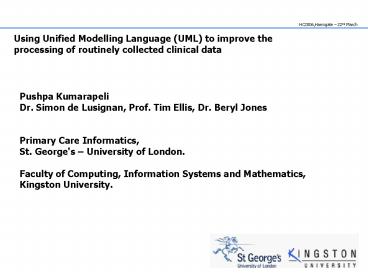Using Unified Modelling Language UML to improve the PowerPoint PPT Presentation
1 / 16
Title: Using Unified Modelling Language UML to improve the
1
HC2006,Harrogate 22nd March
Using Unified Modelling Language (UML) to improve
the processing of routinely collected clinical
data
Pushpa Kumarapeli Dr. Simon de Lusignan, Prof.
Tim Ellis, Dr. Beryl Jones Primary Care
Informatics, St. George's University of
London. Faculty of Computing, Information
Systems and Mathematics, Kingston University.
2
HC2006,Harrogate 22nd March
?Process modelling concepts ?Introduction to
the system The PCDQ programme ?Objectives of
modelling ?Selecting the technique ?Developmen
t of the model ?Results
3
HC2006,Harrogate 22nd March
?Process modelling concepts What is a model? -
An abstract representation of a system Why
should (shouldnt) we model? Provides an
argumentative framework Gain insight apply
for reasoning A focal point to review
foundation to designing Easily interpretable
How to develop a model?
Modelling principles 1. What is modelled
influences the level of insight 2. Verity of
levels for every system 3. No single model
represents the totality 4. Interrelated models
should project a single semantic whole
4
HC2006,Harrogate 22nd March
? Introduction to the system The Primary Care
Data Quality (PCDQ) programme - An educational
intervention using general practice data -
Chronic disease management, health services
planning, research Complex datasets are
extracted from the participating GP practices
using the MIQUEST (Morbidity Query and Export
Syntax) Eight distinctive steps (1) design (2)
data entry appraisal (3) extraction (4) migration
(5) integration (6) cleaning (7) processing (8)
analysis Varying size of datasets, number of
practices, processing Analysis techniques.
5
HC2006,Harrogate 22nd March
? Objectives of modelling Complex mechanisms for
data cleaning and processing are used How do we
try to raise the quality of our data
processing? Eight step processing Error
reduction strategies Metadata framework Data
preparation techniques Validation routines
Referential integrity, traceability But
still Difficult to predict Estimates get
effected Time consuming Exceptions occur
Process modelling objectives (1). Increasing the
predictability with precise execution schedules
(2). Reducing the processing time by optimized
workflow (3). Increasing the process awareness
with improved communication
6
HC2006,Harrogate 22nd March
? Selecting the technique Selection of modelling
and information gathering technique Criteria for
selection Modelling techniques we
compared Integrated Definition for Function
Model (IDEF0) Data Flow Diagrams
(DFD) Unified Modelling Language (UML) Why
we decided to use UML? Mulidimesional
insight Availability of extentions
7
HC2006,Harrogate 22nd March
? Development of the model What data do we need
to build a UML model? Things
Relationships Information requirements for the
model (1) Domain concepts, its actors and their
roles (2) System operations, events and their
attributes (3) Relationships and their nature
(4) Domain components, their possible states and
transition How to gather the data we
need? Different knowledge types need different
techniques We used Activty study
techniques interviews, discussions, think-aloud
sessions, document analysis and observations
8
HC2006,Harrogate 22nd March
? Model development summary
How to model? What modelling technique?
Process view
PCDQ system characteristics
Re-engineering objectives
Design view
UML
UML
Use case view
Information gathering techniques
How to gather information, What techniques?
Use case reports
9
HC2006,Harrogate 22nd March
? Use Case Report
10
HC2006,Harrogate 22nd March
- Use Case Diagram
- PCDQ system
11
HC2006,Harrogate 22nd March
- Class Diagram
- PCDQ system
12
Collection_schedulle
Data extraction
Visit practice
HC2006,Harrogate 22nd March
Not ready
Re-schedule
- Activity Diagram
- Data extraction stage
Queries loaded
Examine system
HQL_query Selected
Db not prepared
No MIQUEST
Enable MIQUEST
Prepare database
Set agreement
HQL_query Updated
Update queries
HQL_query Authorised
Import Authorise
Correct queries
Rejected
Busy
Revisit for collection
Set timer
Wait for execution
System failed
Queries failed
Executed
Export responses
Responses Authorised
Large file size
Network copy
Split files
Create diskette
Diskette Origin
13
SD Data extraction
GP_practice
HQL_query
- Sequence Diagram
- Data extraction stage
selectQuerySet
practiceVisit ! complete
loadQuery()
loop
verifyReadyness
Readyness
available
alt
examineSystem
systemStatus
setAgreement()
updateQuery()
import()
authorise()
verifyExecution
authrisation
setTimer()
system busy
alt
Responses
run()
else
else
systemStatus
getResponse()
checkQueryStatus
queryStatussuccess AND practiceStatusready
authorise()
alt
Diskette
exportResponses
label()
template()
validate()
localQueriesyes
opt
makeLocals()
localFeedBack
resetMiquest
collectionComplete
else
14
HC2006,Harrogate 22nd March
- Outcomes
- What we saw (from the model)?
- ?Set of complex processes
- ?Each stage highly dependant on the preceding
- ?Process ran as a sequence with little work done
in parallel - ?Controls and feedback concentrated to earliest
and last stages - ?Final stage analysis was the least standard
and hardest to model - ?Problems in the intermediate steps were handled
by individual team - members in relative isolation
- ?Less control and communication
- How to improve (according to the model)?
- ?Well defined set of structured outputs at each
stage - ?Draft data set from the pilot stage should be
more carefully analysed - ?Steps taken to overcome problems at the pilot
stage should be - documented
- ?Data aggregation and other later steps could
start in parallel - ?Any finding should be effectively communicated
back to early stages
15
HC2006,Harrogate 22nd March
- Message
- UML diagrams can be used to model a clinical
research process. - Successful UML abstraction needs efficient
information gathering - techniques and selection of appropriate diagrams
to meet the - objectives.
- Further research is needed to explore the use of
UML in clinical - Research and other aspects of health services
including guidelines - to selection of UML notations and extension
mechanisms.
16
HC2006,Harrogate 22nd March
- Thank you
- Questions or comments
- Pushpa ? P0505680_at_sgul.ac.uk
- Dr. Simon de Lusignan ? slusigna_at_sgul.ac.uk

